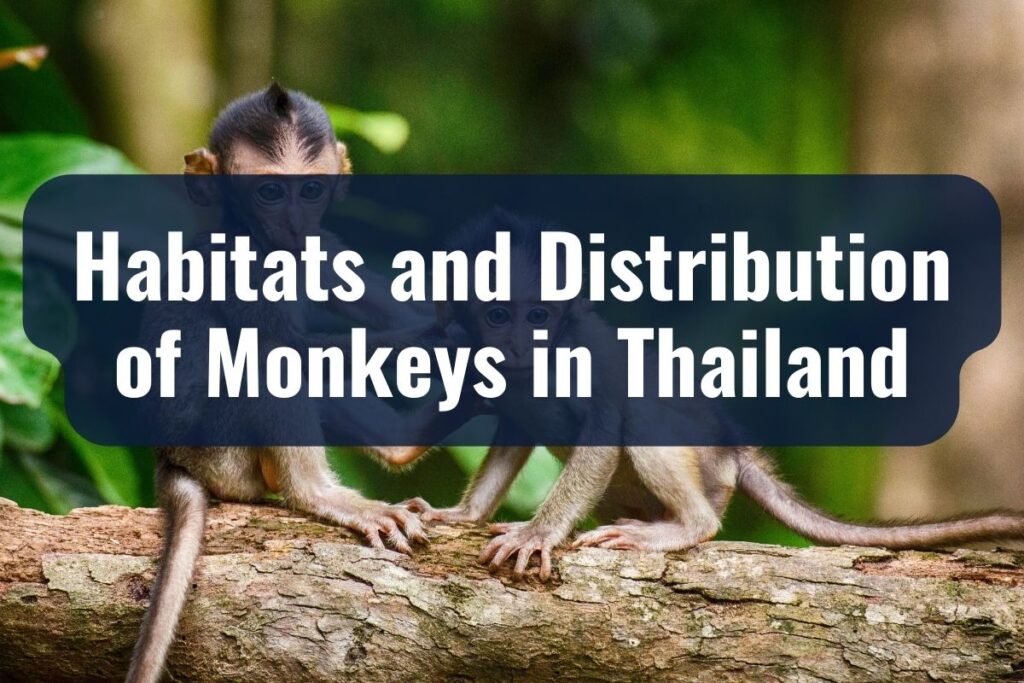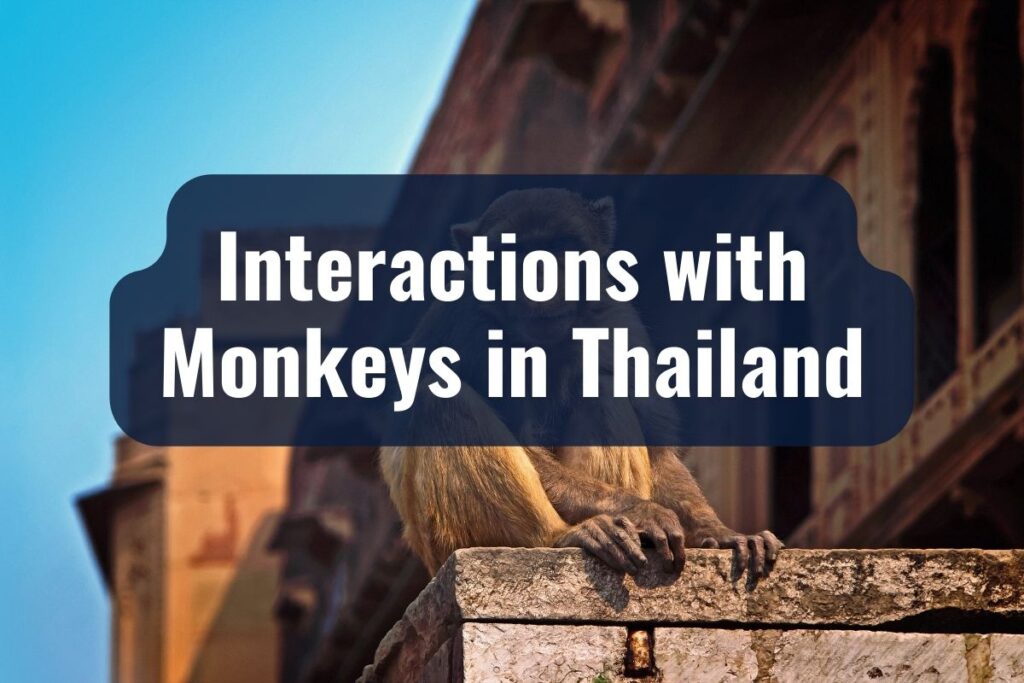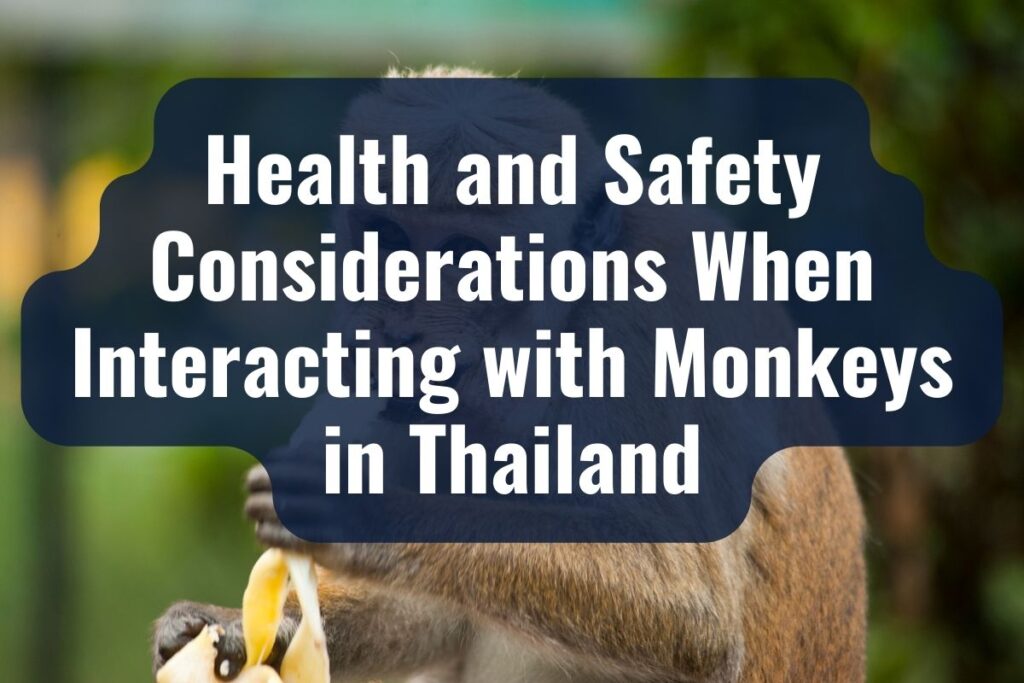Thailand is home to a fascinating array of monkey species. These creatures, ranging from the playful macaques to the more elusive langurs, are an integral part of the country’s natural heritage.
Monkeys in Thailand are not just confined to the remote jungles; they often make appearances in urban areas, temples, and tourist spots. This close proximity to human habitats makes it crucial for foreigners to understand monkey behavior.
In this article, we’ll explore the various species of monkeys found in Thailand, their habitats, and how they interact with the environment and humans. This guide aims to provide informative insights, helping you navigate your experiences with these intriguing creatures with a sense of understanding and respect.
KEY TAKEAWAYS
- Monkeys are an integral part of Thailand’s wildlife and culture.
- Common species include Macaques and Langurs, each with unique behaviors.
- Monkeys inhabit diverse environments from forests to urban areas.
- Cultural significance spans from mythology to modern tourism.
- Human interactions should be respectful and cautious.
- Conservation efforts and laws protect Thailand’s monkey populations.
- Health risks require careful interaction and awareness.
- Responsible tourism promotes monkey welfare and conservation.
- Diverse resources are available for further learning about Thai monkeys.
Species of Monkeys in Thailand
In Thailand, the diversity of monkey species is both fascinating and complex. Two of the most commonly encountered species are the Macaques and Langurs, each with distinct characteristics and behaviors.
Macaques
Characteristics: Macaques are perhaps the most recognized monkey species in Thailand. They have a stout body, a short tail, and are often seen in groups. The Long-tailed Macaque and the Rhesus Macaque are prevalent sub-species.
Behavior: These monkeys are known for their high level of social interaction and intelligence. They are often seen engaging in grooming, playing, and foraging activities within their troops.
Langurs
Characteristics: Langurs, particularly the Dusky Langur, are noted for their slender bodies, long tails, and distinctive coloration, which varies from silver-grey to golden-brown.
Behavior: Langurs are generally more reserved and shy compared to Macaques. They are arboreal, spending most of their time in trees, and are less likely to interact with humans.
Key Differences Between Species
| Species | Habitat | Behavior | Interaction with Humans |
| Macaques | Urban areas, temples, forests | Social, intelligent, often seen in groups | Accustomed to human interaction, can be mischievous |
| Langurs | Tropical forests, mountainous regions | Reserved, arboreal, spends time in trees | Less confrontational, prefers less human interaction |
Understanding the differences between these species is crucial for foreigners. Macaques, often found in urban areas and temples, are more accustomed to human interaction, sometimes leading to conflicts due to their mischievous nature. Langurs, on the other hand, prefer forested areas and are less confrontational.
Habitats and Distribution of Monkeys in Thailand

Common Habitats of Thai Monkeys
The monkeys in Thailand have adapted to a variety of habitats, ranging from dense forests to urban landscapes. This adaptability reflects their resilience and the diverse ecosystems of Thailand.
Forest Dwellers
Tropical Forests: Many monkey species, particularly Langurs, are found in the tropical forests of Thailand. These areas provide a natural habitat with abundant food sources and trees for shelter.
Mountainous Regions: Some species, like certain types of Macaques, are adapted to the cooler climates of mountainous areas, where they find unique food sources and nesting areas.
Urban Monkeys
Temple Areas: Monkeys, especially Macaques, are commonly seen around temples and religious sites. These areas often become unofficial sanctuaries where monkeys coexist with monks and visitors.
City Outskirts: In some urban areas, especially those adjacent to forests or rural landscapes, monkeys can be seen venturing into human habitats in search of food.
Distribution Across Thailand
The distribution of monkeys in Thailand varies with the species and their adaptability to different environments. Macaques are more widespread, found across various regions from the bustling streets of Bangkok to the serene settings of rural temples. Langurs, with their preference for dense foliage and quieter environments, are predominantly found in the forests and less urbanized areas.
Regional Variations
Northern Thailand: Known for its mountainous terrain and cooler climate, Northern Thailand is home to a variety of monkey species that have adapted to this environment.
Southern Thailand: The tropical forests and coastal regions of Southern Thailand offer a different ecosystem, supporting a diverse range of monkey populations.
Cultural Significance of Monkeys in Thailand
Monkeys in Thai Culture and Mythology
Monkeys have held a prominent place in Thai culture and mythology for centuries, symbolizing various attributes and playing significant roles in folklore and religious narratives.
The Ramakien Epic
Role in Mythology: In Thailand’s national epic, the Ramakien, monkeys are portrayed as heroic figures. The most notable is Hanuman, a revered monkey god who symbolizes strength, loyalty, and bravery.
Cultural Impact: This epic has influenced Thai culture deeply, with monkeys being viewed as symbols of good luck and protectors against evil spirits in some beliefs.
Monkeys in Contemporary Thai Society
The perception of monkeys in modern Thai society is multifaceted, ranging from reverence in certain contexts to issues of wildlife management in others.
Festivals and Celebrations
Monkey Festivals: Certain towns in Thailand, like Lopburi, host annual monkey festivals where monkeys are celebrated with feasts and ceremonies. These events attract both locals and tourists, highlighting the cultural importance of monkeys.
Art and Entertainment: Monkeys also appear in traditional Thai art, performances, and puppetry, showcasing their enduring influence on Thai cultural expressions.
Monkeys and Tourism
Monkeys have become an integral part of Thailand’s tourism industry, with many tourists eager to witness these animals in their natural habitat or in iconic locations like temples.
Responsible Tourism
Ethical Considerations: While monkeys attract tourists, it’s crucial to promote ethical tourism practices that respect the monkeys’ well-being and natural behavior.
Educational Opportunities: Tourist interactions with monkeys provide opportunities to educate visitors about the cultural significance of these animals and the importance of wildlife conservation in Thailand.
Interactions with Monkeys in Thailand

Typical Interactions Between Monkeys and People
In Thailand, interactions between humans and monkeys are common, especially in areas where urban and natural habitats converge. Understanding these interactions is key for foreigners to navigate their encounters with monkeys effectively and safely.
In Urban and Tourist Areas
Feeding by Locals and Tourists: Monkeys in urban and tourist areas, particularly Macaques, often receive food from humans. While this can lead to playful and seemingly friendly interactions, it also raises concerns about health and behavior.
Monkeys in Daily Life: In some regions, monkeys are a regular part of the local landscape, seen in markets, temples, and even residential areas, engaging with people in various ways.
In Natural Habitats
Observing in the Wild: In forested areas and national parks, interactions are more observational, with humans watching monkeys in their natural behaviors, such as foraging, grooming, and socializing.
Tips for Safe and Respectful Interactions
For foreigners, understanding how to interact with monkeys responsibly is crucial. Here are some tips:
- Do Not Feed the Monkeys: Feeding alters natural behaviors and diets, and can lead to aggression.
- Keep a Respectful Distance: Avoid getting too close or trying to touch monkeys, as this can be perceived as a threat.
- Secure Personal Belongings: Monkeys, especially in tourist areas, can be curious and may grab loose items like sunglasses or cameras.
- Observe Don’t Disturb: Enjoy watching monkeys, but avoid disturbing their natural activities or habitats.
Addressing Common Issues
Foreigners should also be aware of common issues that can arise from interactions with monkeys:
Aggressive Behavior: Monkeys can sometimes become aggressive, especially if they feel threatened or are accustomed to being fed by humans.
Health Risks: There are health risks associated with close contact, such as bites or scratches. It’s important to be cautious and seek medical attention if needed.
Conservation and Legal Aspects of Monkeys in Thailand
Conservation Efforts for Monkey Species
In Thailand, conservation of monkey species is a vital aspect of maintaining the country’s rich biodiversity and natural heritage. These efforts are essential to ensure the survival and welfare of these primates.
Wildlife Protection Initiatives
- Government and NGO Roles: Various government agencies and non-governmental organizations (NGOs) in Thailand are involved in wildlife conservation, focusing on habitat preservation, research, and public education about monkeys.
- Rehabilitation and Rescue Centers: There are dedicated centers for the rehabilitation of injured or orphaned monkeys, aiming to reintroduce them into their natural habitats whenever possible.
Biodiversity and Ecosystem Preservation
- Protecting Habitats: Efforts to conserve monkey habitats, such as forests and mangroves, are crucial. This includes preventing deforestation and managing urban expansion to minimize habitat loss.
- Species Preservation Programs: Special programs targeting endangered monkey species help in monitoring their populations and implementing measures to protect them from threats like poaching and illegal wildlife trade.
Legal Regulations Regarding Wildlife
Understanding the legal framework regarding wildlife in Thailand is important for foreigners, as it governs interactions with monkeys and their habitats.
Wildlife Protection Laws
- Conservation Laws: Thailand has laws and regulations in place to protect wildlife, including monkeys. These laws prohibit activities like hunting, capturing, or trading protected species.
- Regulations for Human-Monkey Interactions: There are also specific regulations concerning feeding, disturbing, or harming monkeys, especially in national parks and conservation areas.
Penalties and Enforcement
- Legal Consequences: Violations of wildlife protection laws can result in penalties, including fines and imprisonment.
- Role of Enforcement Agencies: Various government agencies are responsible for enforcing these laws, ensuring that wildlife, including monkeys, is protected from illegal activities and unethical treatment.
Health and Safety Considerations When Interacting with Monkeys in Thailand

Understanding Health Risks
Interactions with monkeys, while often fascinating, can pose certain health risks to humans. It’s important for foreigners to be aware of these risks and take necessary precautions.
Risk of Disease Transmission
Zoonotic Diseases: Monkeys can carry diseases that are transmissible to humans, such as rabies and herpes B virus. Although rare, these diseases can be serious.
Precautions: Avoiding direct contact, especially with wild monkeys, is key to minimizing the risk of disease transmission.
Injuries from Monkey Interactions
Bites and Scratches: Monkeys, especially if provoked or accustomed to human interaction, can bite or scratch, leading to injuries.
First Aid and Medical Attention: In case of a bite or scratch, immediate first aid should be administered, and medical attention should be sought, particularly for rabies vaccination.
Safety Tips for Foreigners
For foreigners living in or visiting Thailand, understanding how to safely interact with monkeys is crucial for both their own safety and the welfare of the monkeys.
Keeping a Safe Distance
- Respect Boundaries: Maintain a respectful distance from monkeys to avoid unintentional provocation.
- Observation Over Interaction: It’s safer and more respectful to observe monkeys from a distance rather than trying to interact with them.
Responsible Behavior
- Do Not Feed Monkeys: Feeding monkeys can encourage aggressive behavior and dependency on human-provided food, which is unhealthy for them.
- Securing Personal Items: Monkeys are known to be curious and can snatch personal items like glasses, cameras, or food.
When to Seek Help
In situations where safety is a concern, or if an injury occurs, knowing when and where to seek help is important.
Emergency Services and Local Authorities
- Medical Assistance: For any injuries related to monkey interactions, immediate medical attention should be sought.
- Contacting Wildlife Authorities: In cases of aggressive monkey behavior or concerns about monkey welfare, contacting local wildlife authorities or conservation officers is advisable.
Related: Emergency Numbers in Thailand: What You Need To Know
Responsible Tourism and Monkey Welfare in Thailand
The Role of Tourists in Monkey Conservation
Tourism plays a significant role in both positively and negatively impacting monkey populations in Thailand. Responsible tourism practices are essential to ensure that tourist interactions with monkeys contribute to their welfare and conservation.
Impact of Tourism on Monkeys
Influence on Behavior: Tourist behavior can significantly influence monkey habits, especially when it involves feeding or close interaction.
Supporting Conservation Efforts: Tourists have the opportunity to support conservation efforts through ethical tourism choices, donations, and raising awareness.
Guidelines for Ethical Monkey Encounters
For foreigners visiting monkey habitats or encountering them in urban settings, adhering to ethical guidelines is crucial for the animals’ well-being.
Do’s and Don’ts
- Do:
- Observe monkeys from a distance.
- Support local conservation projects and initiatives.
- Learn about the species and their natural behaviors.
- Don’t:
- Feed or try to touch the monkeys.
- Disturb their natural environment.
- Encourage or participate in activities that exploit monkeys.
Promoting Sustainable Tourism Practices
Sustainable tourism practices help in maintaining the balance between enjoyable tourist experiences and the health and safety of monkey populations.
Choosing Responsible Tour Operators
- Research: Opt for tour operators that promote and practice ethical wildlife viewing.
- Awareness: Be aware of the policies regarding wildlife interactions and choose activities that respect animal welfare.
Contributing to Local Communities
Supporting Local Economy: Engaging with local communities and supporting their economy can also contribute to effective monkey conservation, as many communities play a vital role in protecting local wildlife.
The Way Forward
Responsible tourism is not just about preserving the wildlife; it’s about creating a harmonious relationship between humans and animals. By being mindful of our actions and their impact, we can ensure that the monkeys of Thailand continue to thrive in their natural habitats while being a source of wonder and education for visitors.
Related: How to Be Polite in Thailand: A Practical Guide for Foreigners
Additional Resources
- Wildlife Conservation Websites: Websites of NGOs and government agencies dedicated to wildlife conservation in Thailand often have sections on monkeys, including information about species, habitats, and conservation efforts.
- Travel and Expat Blogs: Blogs written by expats and travelers in Thailand can provide personal insights and experiences regarding interactions with monkeys.
Department of National Parks, Wildlife and Plant Conservation: This government department is responsible for wildlife conservation and can provide information and assistance regarding wildlife interactions and conservation areas.
Wildlife and Conservation Courses: Some organizations offer workshops or courses on wildlife conservation, which can include modules on monkeys and their habitats.
Conservation Projects: Participating in conservation projects can provide hands-on experience and a deeper understanding of monkey behavior and conservation efforts.


